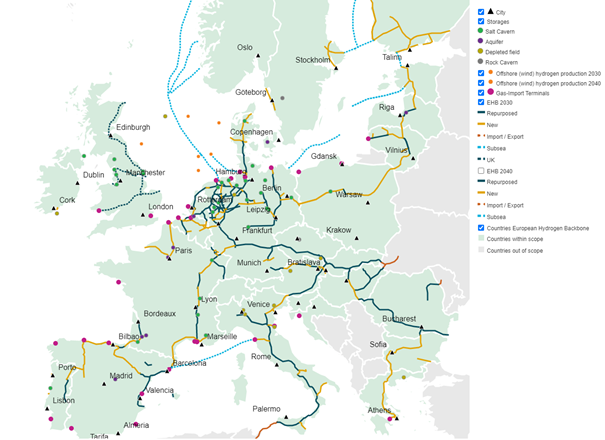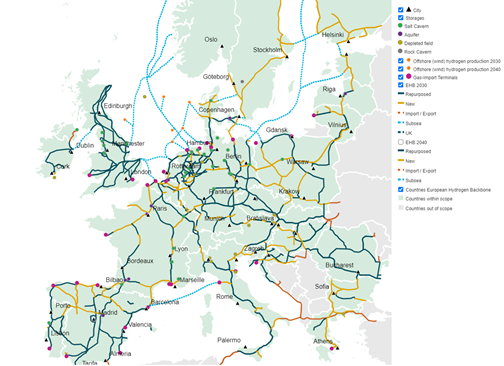THE EUROPEAN HYDROGEN BACKBONE
The European Hydrogen Backbone (EHB) is a proposed infrastructure project that aims to support the use of hydrogen as a clean energy source in Europe. It is intended to be a comprehensive network of hydrogen production, storage, and distribution facilities that will be built across the European Union (EU). The goal of the European Hydrogen Backbone is to enable the widespread adoption of hydrogen technologies in the EU, particularly in sectors where it is difficult to decarbonize using other technologies.
The European Hydrogen Backbone is expected to be a key element of the EU's efforts to decarbonize its energy system and to meet its climate and energy targets. It is intended to support the development of a number of sectors, including transport, industry, and power generation.
The specific details of the European Hydrogen Backbone, including the exact location of production, storage, and distribution facilities, have not yet been finalized. However, the European Commission has identified a number of key challenges that must be addressed in order to make the European Hydrogen Backbone a reality. These challenges include:
· Developing cost-effective and efficient production technologies: Hydrogen can be produced using a variety of technologies, including electrolysis, steam methane reforming, and biomass gasification. However, these technologies are currently relatively expensive and inefficient, and improvements will be needed in order to make the production of hydrogen competitive with other energy sources.
· Building the necessary infrastructure: In order to support the widespread use of hydrogen, a comprehensive network of production, storage, and distribution facilities will be needed. This will require significant investment in infrastructure, including pipelines, storage tanks, and filling stations.
· Ensuring the safety and reliability of hydrogen systems: Hydrogen is a highly flammable gas, and care must be taken to ensure that hydrogen systems are safe and reliable. This will require the development of appropriate safety standards and the establishment of robust safety procedures.
· Overcoming regulatory barriers: The development of the European Hydrogen Backbone will require the coordination of efforts across a number of different countries and sectors. This will require the development of a regulatory framework that is conducive to the development of hydrogen technologies.
Overall, the European Hydrogen Backbone is ambitious and complex project that will require significant investment and coordination in order to be successful. However, if successful, it has the potential to play a major role in the decarbonization of the EU's energy system and the achievement of its climate and energy targets.
Total investment costs of the envisaged 2040 European Hydrogen Backbone are expected to range from €27 to €64 billion, covering the full capital cost of building and retrofitting the backbone. This compares to the hundreds of billions in investments in green hydrogen production that the EC Hydrogen Strategy foresees, already for the period up to 2030. The 22,900km backbone will consist of 75% retrofitted pipelines, with diameters ranging between 60-120cm, and will provide 3-13 GW (LHV) transport capacity per pipeline. In the medium case, 60% of the total investment costs will be dedicated to pipeline works and the remaining 40% will be spent on compression equipment.
While 75% of the total network or almost 18,000km will consist of retrofitted infrastructure, this represents only around 50% of the total investment, which shows the value of making use of existing pipelines (European Hydrogen Backbone Report, 2020, s. 11).

